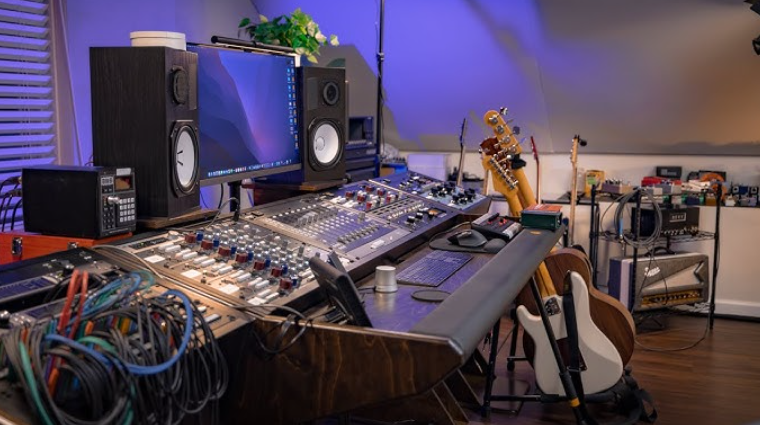Laying Down Tracks: Building Your Recording Studio from the Ground Up

In the heart of every musician, there’s often a quiet dream – a vision of a space where creativity is unhindered, and the sound of their music can be moulded, shaped, and captured just as they hear it in their minds. For many, that dream materializes as a personal recording studio. Building such a haven, however, is not an overnight feat; it’s a deliberate process that demands patience, planning, and a dash of passion.
In this guide, we’ll walk through the intricate steps of constructing a recording studio from the ground up, offering valuable insights for audiophiles, aspiring producers, and seasoned artists looking to create or upgrade their sanctuaries of sound.
Contents
Planning Your Space
Before diving into the construction details, it is crucial to have a clear vision of what you want your recording studio to be.
Location Considerations
Your studio’s location can significantly affect the sounds you’ll capture. It’s essential to balance proximity to the outside world for convenience with isolation to prevent external noise from bleeding into your recordings. Acoustics should also inform this choice – a rectangular room typically lends itself better to sound recording than an irregularly shaped one.
Acoustic Treatment
With your space chosen, treating your room’s acoustics is paramount. The right balance of absorption and diffusion can transform the ambience from an echoing cavern to a controlled environment where you can trust what you hear. Bass traps in the corners, diffusers on reflective walls, and broadband absorbers in strategic areas can create an acoustically transparent space Sound panels for walls and ceilings must be considered, as well.
Equipment Layout
The layout of your equipment is not just a matter of convenience; it influences how you interact with your studio. Position monitors symmetrically at ear level to form an equilateral triangle with your mixed position. Microphone placement should consider the room’s natural reflection points and potential sound sources.
Essential Equipment
Aside from the instruments and recording equipment, a studio needs a few core components to function.
Microphones
Microphones are your studio’s ears, with characteristics and best use cases. A good all-rounder, such as a large diaphragm condenser and a dynamic microphone, are great starting points for most home studios. Invest in quality to ensure an accurate and uncoloured representation of your sounds.
Interface and DAW
Your audio interface is the gateway to your digital audio workstation (DAW), so select one that accommodates your expected input needs and offers clean preamps. The DAW you choose is the nerve centre of your production process – from recording and editing to mixing and mastering, so pick one that you’re comfortable with and has a workflow that suits you.
Monitors and Headphones
Monitor speakers are the voice of your studio, translating recordings and mixes. They must be flat and uncoloured to represent what’s been captured accurately. Quality studio headphones are the second most important factor in monitoring, mainly if your room’s acoustics still need to be perfected.
Furnishing and Decor
While less vital than the recording equipment, studio furniture and decor are still essential. They affect acoustics, ergonomics, and comfort.
Comfortable Seating
If you’re going to spend countless hours in your studio, a comfortable and supportive chair isn’t a luxury – it’s a necessity. Your back will thank you for investing in ergonomic seating that allows you to focus on your music instead of discomfort.
Lighting
Lighting sets the mood and is crucial for those late-night sessions. Ensure your studio is well-lit, but you also can dim the lights or install coloured lighting to add ambience. Music is about atmosphere, and lighting is an often-overlooked element that contributes significantly.
Aesthetics
The visual design of your studio is the first impression it gives. It doesn’t need to be extravagant, but the aesthetics should reflect the energy you want to create within its walls. Clean and minimal, warm wood tones, futuristic LED displays; whatever your style, make it match the sonic landscape.
Technical Setup and Troubleshooting
Now that your studio is built connecting all the moving parts is time. The technical setup can be daunting but can be broken down into smaller tasks.
Cable Management
Cable management is an often underestimated aspect of a studio’s functionality. Label and organize all cables—and consider using colour coding—for quick and easy troubleshooting and setup. Keep them off the floor to prevent damage and to facilitate cleaning and room reconfiguration.
Power Conditioning
A clean power supply can significantly affect your studio’s noise floor. Invest in a power conditioner to protect your equipment from surges and spikes and ensure an even and stable flow of electricity.
Room Calibration
If your room is correctly calibrated, you’ll be one step closer to faithful sound. Acoustic measurement systems can help identify problematic frequencies and provide professional room treatment and speaker placement guidelines.
Promotion and Marketing
Once your studio is up and running, it’s time to promote it. This is essential whether you’re using your space for personal projects or looking to attract clients.
Showcasing Your Studio
Once your studio is up and running, your best marketing tool is the quality of work that comes from it. Record and produce exceptional music that speaks for itself. Additionally, ensure your studio space is aesthetic, organized, and presentable for visiting clients or those interested in hiring your services.
Networking with Artists and Producers
Build a network of musicians, producers, and industry contacts. Attend local events, engage with online communities, and consider collaborating on projects. Word-of-mouth is a powerful marketing tool, especially in the music industry.
Online Presence and SEO Strategies
Create a website and social media profiles to showcase your work and connect with potential clients. Use search engine optimization (SEO) to ensure that your studio comes up when people search for recording studios in your area or genre.
Conclusion
Building a recording studio is a labour of love and requires know-how, creative vision, and a relentless pursuit of sonic perfection. It’s a space where your music can be shaped and shared with the world. The cacophony of decisions that comes with constructing such a centre for sound may be daunting, but the symphony of possibilities it provides is infinite. If you have the passion and the patience, there’s no reason not to lay down tracks and bring to life the studio of your dreams.




